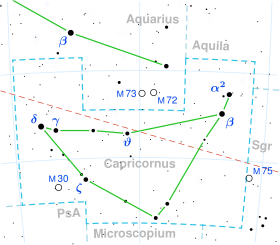Sigma Capricorni, Latinized from σ Capricorni, is a solitary[8] star in the southern constellation of Capricornus,[7] 0.5 degree north of the ecliptic. It is visible to the naked eye as a dim, orange-hued star with an apparent visual magnitude of +5.31.[2] The star is about 1,070 light years away from the Sun based on parallax, but is drifting closer with a radial velocity of −9.6 km/s.[1]
| Observation data Epoch J2000.0 Equinox J2000.0 (ICRS) | |
|---|---|
| Constellation | Capricornus |
| Right ascension | 20h 19m 23.60402s[1] |
| Declination | −19° 07′ 06.6967″[1] |
| Apparent magnitude (V) | +5.31[2] |
| Characteristics | |
| Spectral type | K2 III[3] |
| U−B color index | +1.56[2] |
| B−V color index | +1.43[2] |
| Astrometry | |
| Radial velocity (Rv) | −9.64±0.16[1] km/s |
| Proper motion (μ) | RA: +8.07[4] mas/yr Dec.: −11.31[4] mas/yr |
| Parallax (π) | 3.0609 ± 0.1194 mas[1] |
| Distance | 1,070 ± 40 ly (330 ± 10 pc) |
| Absolute magnitude (MV) | −2.38[5] |
| Details | |
| Mass | 6.3±0.7[6] M☉ |
| Radius | 67.5+4.2 −6.0[1] R☉ |
| Luminosity | 1,392±64[1] L☉ |
| Temperature | 4292+204 −127[1] K |
| Age | 60.5±17.2[6] Myr |
| Other designations | |
| Database references | |
| SIMBAD | data |
This object is an evolved, K-type giant star with a stellar classification of K2 III.[3] Having exhausted the supply of hydrogen at its core, it has expanded and now has around 67.5[1] times the girth of the Sun. The star is about 60.5[6] million years old with 6.3[6] times the mass of the Sun. It is radiating 1,392[1] times the luminosity of the Sun from its swollen photosphere at an effective temperature of 4,292 K.[1]
A magnitude 9.43 visual companion is at an angular separation of 55.90″ along a position angle of 179°, as of 2016.[9]
References edit
- ^ a b c d e f g h i j k Brown, A. G. A.; et al. (Gaia collaboration) (August 2018). "Gaia Data Release 2: Summary of the contents and survey properties". Astronomy & Astrophysics. 616. A1. arXiv:1804.09365. Bibcode:2018A&A...616A...1G. doi:10.1051/0004-6361/201833051. Gaia DR2 record for this source at VizieR.
- ^ a b c d Fernie, J. D. (May 1983), "New UBVRI photometry for 900 supergiants", Astrophysical Journal Supplement Series, 52: 7–22, Bibcode:1983ApJS...52....7F, doi:10.1086/190856.
- ^ a b Houk, N.; Smith-Moore, M. (1988), Michigan Catalogue of Two-dimensional Spectral Types for the HD Stars, vol. 4, Bibcode:1988mcts.book.....H.
- ^ a b van Leeuwen, F. (2007), "Validation of the new Hipparcos reduction", Astronomy and Astrophysics, 474 (2): 653–664, arXiv:0708.1752, Bibcode:2007A&A...474..653V, doi:10.1051/0004-6361:20078357, S2CID 18759600.
- ^ Anderson, E.; Francis, Ch. (2012), "XHIP: An extended hipparcos compilation", Astronomy Letters, 38 (5): 331, arXiv:1108.4971, Bibcode:2012AstL...38..331A, doi:10.1134/S1063773712050015, S2CID 119257644.
- ^ a b c d Tetzlaff, N.; et al. (January 2011), "A catalogue of young runaway Hipparcos stars within 3 kpc from the Sun", Monthly Notices of the Royal Astronomical Society, 410 (1): 190–200, arXiv:1007.4883, Bibcode:2011MNRAS.410..190T, doi:10.1111/j.1365-2966.2010.17434.x, S2CID 118629873.
- ^ a b "* sig Cap". SIMBAD. Centre de données astronomiques de Strasbourg. Retrieved 2017-05-12.
{{cite web}}: CS1 maint: postscript (link) - ^ Eggleton, P. P.; Tokovinin, A. A. (September 2008), "A catalogue of multiplicity among bright stellar systems", Monthly Notices of the Royal Astronomical Society, 389 (2): 869–879, arXiv:0806.2878, Bibcode:2008MNRAS.389..869E, doi:10.1111/j.1365-2966.2008.13596.x, S2CID 14878976.
- ^ Mason, B. D.; et al. (2014), The Washington Visual Double Star Catalog, Bibcode:2001AJ....122.3466M, doi:10.1086/323920
